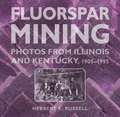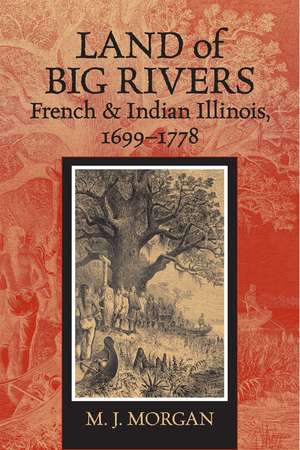Land of Big Rivers: French and Indian Illinois, 1699-1778: Shawnee Books
Autor M. J. Morganen Limba Engleză Paperback – 6 iul 2010
Drawing on research from a variety of academic fields, such as archaeology, history, botany, ecology, and physical science, M. J. Morgan explores the intersection of people and the environment in early eighteenth-century Illinois Country—a stretch of fecund, alluvial river plain along the Mississippi river. Arguing against the traditional narrative that describes Illinois as an untouched wilderness until the influx of American settlers, Morgan illustrates how the story began much earlier.
She focuses her study on early French and Indian communities, and later on the British, nestled within the tripartite environment of floodplain, riverine cliffs and bluffs, and open, upland till plain/prairie and examines the impact of these diverse groups of people on the ecological landscape. By placing human lives within the natural setting of the period—the abundant streams and creeks, the prairies, plants and wildlife—she traces the environmental change that unfolded across almost a century. She describes how it was a land in motion; how the occupying peoples used, extracted, and extirpated its resources while simultaneously introducing new species; and how the flux and flow of life mirrored the movement of the rivers. Morgan emphasizes the importance of population sequences, the relationship between the aboriginals and the Europeans, the shared use of resources, and the effects of each on the habitat.
Land of Big Rivers is a unique, many-themed account of the big-picture ecological change that occurred during the early history of the Illinois Country. It is the first book to consider the environmental aspects of the Illinois Indian experience and to reconsider the role of the French and British in environmental change in the mid-Mississippi Valley. It engagingly recreates presettlement Illinois with a remarkable interdisciplinary approach and provides new details that will encourage understanding of the interaction between physical geography and the plants, animals, and people in the Illinois Country. Furthermore, it exhibits the importance of looking at the past in the context of environmental transformation, which is especially relevant in light of today’s global climate change.
She focuses her study on early French and Indian communities, and later on the British, nestled within the tripartite environment of floodplain, riverine cliffs and bluffs, and open, upland till plain/prairie and examines the impact of these diverse groups of people on the ecological landscape. By placing human lives within the natural setting of the period—the abundant streams and creeks, the prairies, plants and wildlife—she traces the environmental change that unfolded across almost a century. She describes how it was a land in motion; how the occupying peoples used, extracted, and extirpated its resources while simultaneously introducing new species; and how the flux and flow of life mirrored the movement of the rivers. Morgan emphasizes the importance of population sequences, the relationship between the aboriginals and the Europeans, the shared use of resources, and the effects of each on the habitat.
Land of Big Rivers is a unique, many-themed account of the big-picture ecological change that occurred during the early history of the Illinois Country. It is the first book to consider the environmental aspects of the Illinois Indian experience and to reconsider the role of the French and British in environmental change in the mid-Mississippi Valley. It engagingly recreates presettlement Illinois with a remarkable interdisciplinary approach and provides new details that will encourage understanding of the interaction between physical geography and the plants, animals, and people in the Illinois Country. Furthermore, it exhibits the importance of looking at the past in the context of environmental transformation, which is especially relevant in light of today’s global climate change.
Din seria Shawnee Books
- 23%
 Preț: 119.18 lei
Preț: 119.18 lei -
 Preț: 139.40 lei
Preț: 139.40 lei - 20%
 Preț: 152.33 lei
Preț: 152.33 lei -
 Preț: 107.63 lei
Preț: 107.63 lei -
 Preț: 82.07 lei
Preț: 82.07 lei -
 Preț: 112.78 lei
Preț: 112.78 lei - 17%
 Preț: 335.44 lei
Preț: 335.44 lei - 28%
 Preț: 148.50 lei
Preț: 148.50 lei -
 Preț: 107.00 lei
Preț: 107.00 lei - 21%
 Preț: 185.21 lei
Preț: 185.21 lei - 21%
 Preț: 257.71 lei
Preț: 257.71 lei - 15%
 Preț: 367.79 lei
Preț: 367.79 lei -
 Preț: 181.23 lei
Preț: 181.23 lei -
 Preț: 248.58 lei
Preț: 248.58 lei -
 Preț: 180.95 lei
Preț: 180.95 lei -
 Preț: 266.62 lei
Preț: 266.62 lei -
 Preț: 259.67 lei
Preț: 259.67 lei -
 Preț: 223.25 lei
Preț: 223.25 lei
Preț: 199.91 lei
Preț vechi: 266.91 lei
-25% Nou
Puncte Express: 300
Preț estimativ în valută:
38.26€ • 39.64$ • 31.93£
38.26€ • 39.64$ • 31.93£
Carte indisponibilă temporar
Doresc să fiu notificat când acest titlu va fi disponibil:
Se trimite...
Preluare comenzi: 021 569.72.76
Specificații
ISBN-13: 9780809329885
ISBN-10: 0809329883
Pagini: 306
Ilustrații: 18
Dimensiuni: 152 x 229 x 23 mm
Greutate: 0.43 kg
Ediția:1st Edition
Editura: Southern Illinois University Press
Colecția Southern Illinois University Press
Seria Shawnee Books
ISBN-10: 0809329883
Pagini: 306
Ilustrații: 18
Dimensiuni: 152 x 229 x 23 mm
Greutate: 0.43 kg
Ediția:1st Edition
Editura: Southern Illinois University Press
Colecția Southern Illinois University Press
Seria Shawnee Books
Notă biografică
M. J. Morgan is an adjunct professor of history at Kansas State University and the author of numerous articles on French America.
Recenzii
“Brilliantly conceived and beautifully written, this book will transform not only the ways we think about the early Illinois Country, but the ways we write environmental history.”—John Mack Faragher, Yale University
“By studying Illinois ecosystems more comprehensively than any previous historian, Morgan demonstrates how the events of the colonial period left legacies that remain with us today. This is a timely work, reminding us how much our lives have been shaped by recent changes in our natural environment.”—Geoffrey Plank, University of Cincinnati
"With a steady intelligence and a graceful style, M.J. Morgan tells an imaginative story as she traces the ecological shifts that French and Indian interaction created in the Illinois country in the eighteenth century. In doing so, she embeds the Upper Louisiana experience in the natural history of the region. Reading between the lines and peering through keyholes, Morgan draws on a highly impressive range of skills and disciplines to produce this unique reconstruction of events in colonial Illinois. A bold account told with sympathy and courage."—Morris S. Arnold
“By studying Illinois ecosystems more comprehensively than any previous historian, Morgan demonstrates how the events of the colonial period left legacies that remain with us today. This is a timely work, reminding us how much our lives have been shaped by recent changes in our natural environment.”—Geoffrey Plank, University of Cincinnati
"With a steady intelligence and a graceful style, M.J. Morgan tells an imaginative story as she traces the ecological shifts that French and Indian interaction created in the Illinois country in the eighteenth century. In doing so, she embeds the Upper Louisiana experience in the natural history of the region. Reading between the lines and peering through keyholes, Morgan draws on a highly impressive range of skills and disciplines to produce this unique reconstruction of events in colonial Illinois. A bold account told with sympathy and courage."—Morris S. Arnold
Descriere
Land of Big Riversis a unique, many-themed account of the big-picture ecological change that occurred during the early history of the Illinois Country. It is the first book to consider the environmental aspects of the Illinois Indian experience and to reconsider the role of the French and British in environmental change in the mid-Mississippi Valley. M. J. Morganengagingly recreates presettlement Illinois with a remarkable interdisciplinary approach and provides new details of the interaction between physical geography and the plants, animals, and humans in the Illinois Country. Furthermore, Land of Big Riversexhibits the importance of looking at the past in the context of environmental transformation, an especially relevant topic in light of today’s global climate change.
